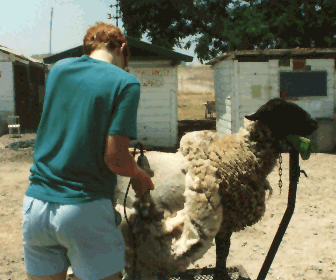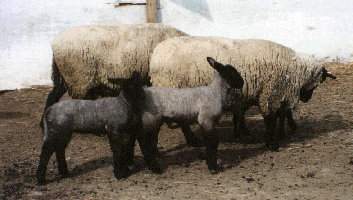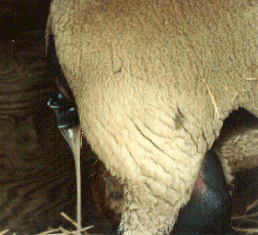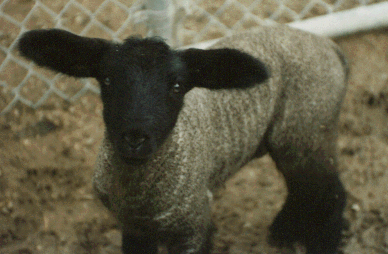

This page discusses all aspects of raising sheep and lambs, including diet, breeding, and preparing for shows. We hope to provide sheep information to help with sheep raising, sheep care, and breeding sheep.
We raised Suffolk sheep, but there really aren't major differences between breeds.
The females are ewes and they tend to weigh less than the males, called rams. Primarily the ewes are the only sheep kept on our farm all year long, as most of the lambs are sold at an auction. Males who are not castrated and turned into wethers are often too smelly to keep and other establishments are better equiped to handle them.
Most of the 4-H members who use our Farm want to raise sheep as market animals. In our area, the Suffolk and Hampshire breeds usually place best at the Fair because of their growth rate and muscling. We have had mostly Suffolks, but some Shropshire, Shropshire/Suffolk crosses, Dorsets, Dorset/Suffolk crosses, Southdowns, Oxfords, Rambouillets, and a Hampshire cross at the Farm. Each of these breeds or crossbreeds has a purpose, but we have had the most success with the Suffolks. Some sheep breeds are better raised for meat; others for wool. Suffolk fleece is not a good quality wool, but the meat is the best!
Walking a lamb every day after school can be relaxing.
Keeping yourself dry while washing a lamb is impossible. If you stay fairly dry for the bath, you'll definitely be soaked when you lift the lamb onto the carding table.
Wet sheep smell like wet wool.
Shearing a lamb in front of an audience is fun.
Trying to remove a fleece all in one piece is challenging.

Sheep do not necessarily seek shelter from rain, but, especially when their fleece is long, they seek shade. Provide some type of cover that the sheep can use when the weather is either too sunny or too wet. Newborn lambs lose bodyheat quickly and need protection from the cold, especially wet cold.
To maintain good condition, sheep need exercise. Young lambs romp and play, creating their own activity whenever they're not nursing or resting. A roomy pen or pasture will allow mature ewes and rams to move around as much as needed to maintain good condition. Lambs raised for market, however, need extra activity to make sure that they do not become "overconditioned" or fat. Walk your lamb on a halter for a mile or more every day or set up poles in the pen to encourage the lamb to leap from one end to the other.
Unless the ewe is shorn, and ours have never been shorn in the winter, it is difficult to see some of the changes that happen in the early stages of labor. The pelvic ligaments loosen up, creating a hollow around the dock or tail head. A sign that is easier to detect is a "dropped" look to the abdomen with a hollow below the hip bone.

If you happen to notice the ewe pass her mucous plug or drip gobs of mucous, you will know that the first stage of labor has begun. She may paw the ground or stand away from her usual companions. Later, during the second stage of labor, the ewe will push, first expelling amniotic fluid and later, hopefully, the front feet of the first of several lambs. As you watch her strain and grunt you will understand why this natural process is called "labor." But if the labor continues for an hour or more with no sign of a lamb, someone will need to check to see what is the matter. If the ewe stops pushing, she could be weak because of a selenium deficiency or because the labor has been prolonged without progress. Straining with neither a sack nor feet protruding from the vulva usually means that the lamb is in a position that makes delivery difficult. If you need to assist in the delivery, you will be relieved to learn that the entrance to a ewe's reproductive tract is usually roomy and well lubricated at this time. The hardest part is knowing how long to wait before interfering. The second hardest part is identifying a lamb's body parts when your hand is exploring the inside of the ewe's reproductive tract. Take time to speak with experienced livestock "midwives" and read about lambing before your ewe reaches a stage where you have to make some quick decisions about when and how to help.
Watch for the afterbirth. You can discard it right away or let the ewe eat it. In the wild this is what mothers do to remove some of the birthing smell, hoping to discourage predators. The afterbirth also contains hormones that, when consumed by the mother, stimulate the uterus to contract and return to its normal size.

We need some supplies, though, like a halter ($12 to $16), shampoo, a grain container (a clean metal trash can will do) and scoop ($4), hoof trimmers ($14), scrub brush ($4). Most of our project members like to use baby wipes to clean the inside of a lamb's ears and the groin area where secretions accumulate from lanolin glands. Other optional equipment include lamb "sweaters" ($12) to keep their skin taut and blankets ($25 unless homemade) to keep them clean at showtime.
A. Cost of feeder lamb
____ lb. purchase weight x ____ cents/lb = (1) ____ cost of feeder lamb.B. Cost of concentrates (grain)
2 lb. concentrate/day x ____ days on feed = ____ total lb. concentrate. ____ total lb. concentrate x ____ cents/lb = (2) ____ total cost of concentrates.C. Cost of hay (roughage)
2 lb. hay/day x ____ days on feed = ____ total lb. hay. ____ total lb. hay x ____ cents/lb = (3) ____ total cost of hay.D. Miscellaneous costs
____ Entry fees +
____ Show equipment +
____ Veterinary fees +
____ Other costs =
(4) ____ total miscellaneous costs.
E. Total costs
____ Feeder lamb cost +
____ Concentrate cost +
____ Hay cost +
____ Miscellaneous costs =
(5) ____ total costs.
F. Breakeven price
____ days on feed x .40 lb average daily gain = ____ lb gain
____ lb purchase weight + ____ lb gain = (6) ____ lb final weight
(5) ____ total cost divided by (6) ____ lb final weight =
(7) ____ breakeven price/pound.
Generally, in our area the breakeven price for lambs is about $2 per
pound. This assumes purchasing a weaned lamb for $100 to $125, hay at
$10 to $12 per bale, and averaging 2 pounds of grain per day at $8.50
per 50 pound bag. However, many lambs are raised on 3 to even 6 (!)
pounds of concentrates per day. We have had some very growthy lambs
born at our 4-H Farm that have had to be "held back" to keep their
weight down to 125 to 130 pounds at Fair time. These lambs are either
fed no grain for several weeks or a restricted ration, never more than
one pound per day. These fast growing lambs have been inexpensive to
raise compared to lambs that have to be "pushed" to reach market
weight.In addition to expensive equipment that would add to the cost of raising a market lamb, our project members try to avoid veterinary costs. We take care of routine care such as worming and vaccinations ourselves. Lambs that are born at the Farm are also castrated and docked there. Breeding sheep can be risky and expensive, with less opportunity for profit than just raising a market lamb. Most of the sheep at the 4-H Farm that have needed the care of a veterinarian have been either pregnant or lactating ewes. Only once during the last decade has one of our lambs needed veterinary care.
Sheep have fleece, goats have hair. (Exception: Barbados sheep.)
Sheep say baa goats say maa. Seriously, their voices are different.
Most goats are naturally horned, but many sheep breeds are polled (naturally hornless).
Sheep are stupid, goats are smart. We like sheep, but would never bet money on a lamb trying to find its way out of a maze. As far as survival skills go, though, sheep must be as smart as many other species. They have survived in the wild for hundreds of years all over the world.
Sheep need less copper than goats. Some mineral supplements that are great for goats can be toxic to sheep.
Sheep are more likely to overeat than goats. Be careful about turning sheep into a lush pasture or freefeeding them more hay than they usually eat. Sheep should be vaccinated for enterotoxemia or "overeating" disease. In our area, enterotoxemia has not been a problem for goats on a controlled diet.
Sheep are grazers, goats are browsers. That means sheep are probably better weed eaters, since they eat grasses and other plants all the way down to the ground. Goats, on the other hand, nibble here and there, sampling a variety of bushes and leaves.
Sheep, except those that are tamed by bottlefeeding, are more skittish than goats. Their instinct is to flee, not fight.
Sheep milk is higher in fat than goat milk. Either one can be used to make feta cheese. The Farm cats love both kinds!
Some of these next comments are based on our personal experience raising both sheep and goats in Southern California, sometimes in the same pen. Our observations may be different than yours if you live in a different climate or use pasture yearround for your livestock:
Sheep are more likely to have worms; their favorite is the stomach worm strongyles. Goats are more likely to have coccidia (an intestinal protozoan parasite).
Sheep are less susceptible to external parasites, including fungi such as ringworm. Goats, especially those with longer hair, often have lice. Ringworm is common.
Sheep need hoof trimming much less often (maybe twice per year) than goats (once or twice monthly).

N. Bruce Haynes, Keeping Livestock Healthy: A Veterinary Guide (Storey Communications, Inc., Vermont 1985).
Paula Simmons, Raising Sheep the Modern Way, (Garden Way Publishing, Vermont 1989).
 Latest News About Sheep
Latest News About Sheep
These pages were designed by Erik of the Computer S\ cience project of the Irvine Mesa Charros 4-H Club.